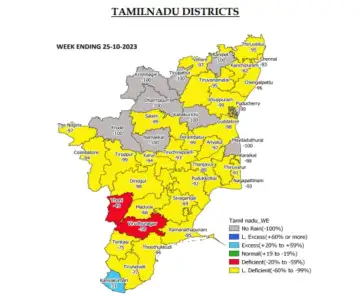
As the twin cyclones over the North Indian Ocean dissipate, they have also ended up drawing moisture from Northeast monsoon which has lost momentum over Tamil Nadu.
According to the India Meteorological Department (IMD), the subdued winter monsoon may take a few more days to gain strength.
“The two intense systems have swept away the moisture that would have otherwise strengthened the northeast monsoon. It is now in a moderate phase. We may have to wait for a few more days until the easterlies provide some momentum,” Dr B Geetha, senior scientist at IMD Chennai, tells News18.
Unlike the southwest monsoon, which covers entire India in four months, the northeast monsoon only brings rain over five sub-divisions – Tamil Nadu, Puducherry, Kerala, South Interior Karnataka, Rayalseema and Coastal Andhra Pradesh during October-December. The region receives 30 per cent of its annual rainfall during this period which has sectoral implications for the water resources and agriculture in the region, especially Tamil Nadu.

The northeast monsoon had made its onset over Kerala and Tamil Nadu with heavy rains on October 21, two days after the southwest monsoon withdrew. A low pressure system also developed over Central Bay of Bengal around the same time, along with a cyclonic circulation over Comorin Sea, creating the perfect conditions for the monsoon onset. On the western side, Extremely Severe Cyclone Tej developed over Southwest Arabian Sea.
IMD PREDICTS WIDESP RAINS OVER KERALA
The rainfall over Tamil Nadu has remained largely deficient over the last week, with no rain recorded in as many as seven districts. However, according to IMD, the next five days may see some light to moderate rain showers in isolated areas in Tamil Nadu, Puducherry, and Coastal Andhra Pradesh.
Kerala and Mahe, on the other hand, continue to witness an active monsoon with several stations recording over 80mm rain in Kerala in the last 24 hours. The weather department has predicted fairly widespread rains over Kerala during the next five days, with heavy rainfall on some days.
“The northeast monsoon is very volatile and influenced by several intra-seasonal variations. This also makes a long-term prediction difficult,” added Dr Seetha. Overall, the IMD has predicted a normal winter monsoon, with rainfall about 88-112 per cent of the Long Period Average (LPA).
TWIN CYCLONES IN NORTH INDIAN OCEAN
Two vigorous cyclones simultaneously stirred the North Indian Ocean over the last five days. While the Extremely Severe Cyclone Tej crossed Yemen coast on Tuesday after losing some intensity, the very severe Cyclone Hamoon that developed over Bay of Bengal made its landfall on the Bangladesh coast on Wednesday morning as a cyclonic storm with wind speed of 75-85 kmph gusting to 95 kmph. Both the storms have now weakened.

